…..Take
a team of six graduates, two British-made 4 x4s with endless support from the
Austin Motor Company, dozens of sponsors, the enthusiastic backing from a university
in a great city and you have an expedition to drive around the world.
Thirteen
months, twenty countries and about 48,280 kms/ 30,000 land miles later and it
became a 'first'. The Around the World journey had never been done in that way
before and certainly never with a Wrayflex - the first and only British made single
lens reflex [SLR] camera ………….
In
Part One we had driven overland from England to India where we stayed for two
months in three villages so our academics could study the social and rural economics.
By the end of December 1960 we had completed the work and we headed south to Ceylon
- now Sri Lanka. We had a fixed schedule to board a Dutch liner in Colombo for
a month long journey to the west coast of South America.
Film
was expensive so every shot was considered. I used a hand held meter to calculate
the amount of light available and adjust for shadows. Each change of lenses say
from the standard Unilix to a wide angle or telephoto took a minimum of 30 seconds.
Changing film at the end of a 36 picture cassette took four minutes or more in
bright light when I had to find shade.
January
6th 1961
 India,
Bandipur Wildlife Sanctuary near Mysore, southern India. We hoped to see a tiger
but had to accept one deer and a fabulous peacock. India,
Bandipur Wildlife Sanctuary near Mysore, southern India. We hoped to see a tiger
but had to accept one deer and a fabulous peacock.
January
8th 1961  India
, In the Nilgiri Hills in Tamil Nadu state - we were there to see a tea estate.
This view looks to ranges over 2500 metres / 8200 feet high . Although the ages
old tea estates have cut into the ancient forests the Nilgiris are part of the
UNESCO backed Nilgiri Biosphere Reserve. India
, In the Nilgiri Hills in Tamil Nadu state - we were there to see a tea estate.
This view looks to ranges over 2500 metres / 8200 feet high . Although the ages
old tea estates have cut into the ancient forests the Nilgiris are part of the
UNESCO backed Nilgiri Biosphere Reserve.
January
14th 1961  Here
at the southwestern tip of Ceylon / Sri Lanka we were to meet Arthur C.
Clarke a British science fiction writer who had settled there in 1956 and his
business partner Mike Wilson a film-maker. Arthur C.Clarke perhaps best known
for his co-writing of Stanley Kubrick's 2001 - A Space Odyssey [1968]
was filming the reefs for a sunken treasure story. Here
at the southwestern tip of Ceylon / Sri Lanka we were to meet Arthur C.
Clarke a British science fiction writer who had settled there in 1956 and his
business partner Mike Wilson a film-maker. Arthur C.Clarke perhaps best known
for his co-writing of Stanley Kubrick's 2001 - A Space Odyssey [1968]
was filming the reefs for a sunken treasure story.
18th
January 1961 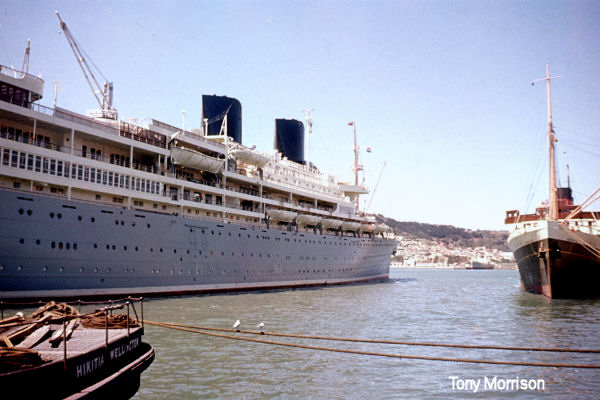 In
Colombo, Ceylon / Sri Lanka We boarded the Dutch liner the MV
Willem Ruys - we had booked well in advance as the liner was on a round-the-world
service mainly for European immigrants bound for Australia and New Zealand and
from there Austalians and New Zealanders heading to Europe. In
Colombo, Ceylon / Sri Lanka We boarded the Dutch liner the MV
Willem Ruys - we had booked well in advance as the liner was on a round-the-world
service mainly for European immigrants bound for Australia and New Zealand and
from there Austalians and New Zealanders heading to Europe.
This
picture was shot in Wellington - New Zealand and is here as it is the only distant
picture of the ship I took on my Wrayflex Tech
apology -The ship is distorted visually because I used the Lustrar wide angle
and I was not accustomed to w/a shooting In
later years the Willem Ruys changed ownership and became the Achille Lauro and
hit the headlines when the Palestine Liberation Front hijacked it in 1985 and
brutally murdered a disabled Jewish American passenger - Leon Klinghofer. The
ship's bad luck concluded when as the Star Lauro it caught fire and sank off Somalia
in 1994. For me....the Willem Ruys was good news so sad RIP. January
22nd 1961  Singapore,
A sampan in the harbour during a brief stop in Singapore which then was
still part of the British Empire though self governing. Singapore,
A sampan in the harbour during a brief stop in Singapore which then was
still part of the British Empire though self governing.
How
times have changed from sixty years ago when it was a small port at the tip of
Malaya.
January
23rd 1961
 On
the deck of the Willem Ruys and about to cross the Equator going
southward. On
the deck of the Willem Ruys and about to cross the Equator going
southward.
I
am reading the Ocean Post News [sent to the ship by
wireless]. January
31st 1961  Melbourne
- Australia. Here we were met by Jim Davern who was working for ABC TV. We
had met Jim in Mashad, Iran when he was making his way home from a stay in London
where he had been on a six month attachment with the BBC Melbourne
- Australia. Here we were met by Jim Davern who was working for ABC TV. We
had met Jim in Mashad, Iran when he was making his way home from a stay in London
where he had been on a six month attachment with the BBC
Jim
took us to the Dandedong Hills and the Healyville Sanctuary. The black and white
picture was taken on my Microflex camera [my British made TLR 6 v6 cms]. Jim is
on the right with Don Pilton our doctor and Peter Krinks - left
Since
those early years Jim Davern has scripted, directed and produced some of Australia's
most popular television programmes and in 2014 he was awarded the Order of Australia
Medal [OAM] for his creative work.
February
3rd 1961  Sydney,
Australia. Picture taken from high on the Harbour Bridge - my diary notes
do not record from which lookout point. Sydney,
Australia. Picture taken from high on the Harbour Bridge - my diary notes
do not record from which lookout point.
February
8th 1961  Wellington,
New Zealand An unforgettable departure from Lambton Quay with hundreds of
paper streamers cast from the travellers on the Willem Ruys to families
and friends on the dockside. Wellington,
New Zealand An unforgettable departure from Lambton Quay with hundreds of
paper streamers cast from the travellers on the Willem Ruys to families
and friends on the dockside.
As the ship moved away the streamers parted symbolically breaking the ties - some
were to be for a few months and some for years.
I
feel I must add that leaving anyone was a powerful experience - contact for most
people was by letter. Telephony existed but often was dodgy with long waiting
times for a connection.
February
14th 1961  Easter
Island in mid-Pacific is astern. Easter
Island in mid-Pacific is astern.
In
1961 this island was
out of reach to most travellers and still had the romantic aura described by the
Norwegian ethnographer Thor Heyerdahl. Heyerdahl's
Aku Aku was published in 1957 after his studies of Rapa Nui - the people
of the island [1955-56]. Heyerdahl
was already known for his 1947 Kon Tiki raft crossing of the Pacific using ocean
currents. After our comfortable crossing all I can say is …Wow what a trip
that must have been!
 February
19th 1961 Arrival in Callao - the port for Lima Peru, where we unloaded our
vehicles and supplies. This picture was not shot on the Wrayflex. It is a 35mm
on a Leica lllg on loan from FG Warne a Bristol photo dealer. February
19th 1961 Arrival in Callao - the port for Lima Peru, where we unloaded our
vehicles and supplies. This picture was not shot on the Wrayflex. It is a 35mm
on a Leica lllg on loan from FG Warne a Bristol photo dealer.
February
26th 1961 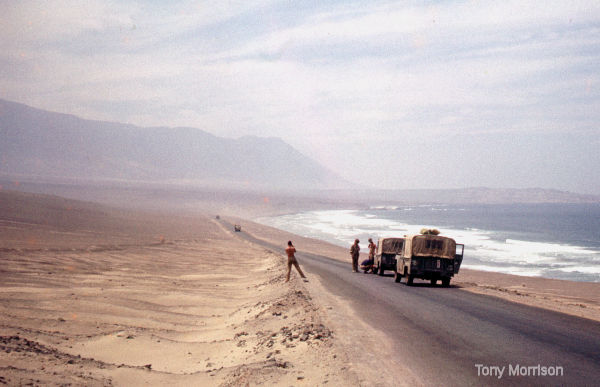 We
were freshly organised and heading south on the tarmac Pan American Highway which
runs through the coastal desert, one of the world's driest places. The
Pacific Ocean is on the right and the foothills of the Andes mountains on the
left. We
were freshly organised and heading south on the tarmac Pan American Highway which
runs through the coastal desert, one of the world's driest places. The
Pacific Ocean is on the right and the foothills of the Andes mountains on the
left.
February
28th 1961
 Naturally
eroded rock in the Peruvian desert. The Pacific is out of the frame and the Andean
mountain foothills make the backdrop Naturally
eroded rock in the Peruvian desert. The Pacific is out of the frame and the Andean
mountain foothills make the backdrop
Sand
blown by the daily wind was responsible for the erosion and passing truck drivers
added the facial touches. March
2nd 1961  At
dawn we had a surprise as we had been camped at a roadside with a perfect view
of the volcano El Misti 5,822 metres / 19,101 feet. At
dawn we had a surprise as we had been camped at a roadside with a perfect view
of the volcano El Misti 5,822 metres / 19,101 feet.
We
were driving up the western slopes of the Andes to cross into Bolivia for a two
month project observing the United Nations at work with the indigenous people. March
4th 1961  We
arrived in Bolivia where the administrative capital La Paz is set close to Mt
Illimani 6,438 metres / 21,122 feet. We
arrived in Bolivia where the administrative capital La Paz is set close to Mt
Illimani 6,438 metres / 21,122 feet.
In
the foreground an Aymara family on the road to Palca - then a small village and
now a suburb of la Paz. Beyond
the mountain the land slopes steeply to Amazonian jungle and for the first time
I sensed I had reached a starting point for a career. March
1961 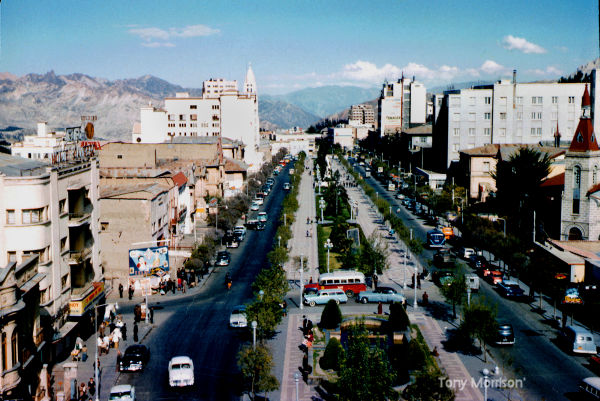 Bolivia, La Paz - The
500 metres long Paseo El Prado which from the early 1900s was the place
to walk among trees - to admire statues - fountains and fine houses.
Bolivia, La Paz - The
500 metres long Paseo El Prado which from the early 1900s was the place
to walk among trees - to admire statues - fountains and fine houses.
By
1961 two hotels flanked the space and today....it's high rises all the way. This
picture was shot on Kodachrome using my Wray Unilux 50mm 2.8 lens.
In high resolution the people are pin-sharp and on the left one advert board for
Agfa film is very clear.
31st
March 1961  Bolivia , La Paz - The old city is out of shot to the left and higher.
Bolivia , La Paz - The old city is out of shot to the left and higher.
In the late 1930s Avenida Camacho centre left was developed and extraordinary
Art Deco buildings were built. The
snow capped Illimani mountain is distant in cloud at the end of Camacho. On
the left is the Hotel La Paz and offices designed by the Yugoslav architect Ivica
Krusul. On the
right is the Club La Paz now protected as a Municipal Heritage Building. All
this is now grey from age and lost within a profusion of high-rises and slow moving
traffic. March
15 1961 Pilllapi and Margaret Anstee 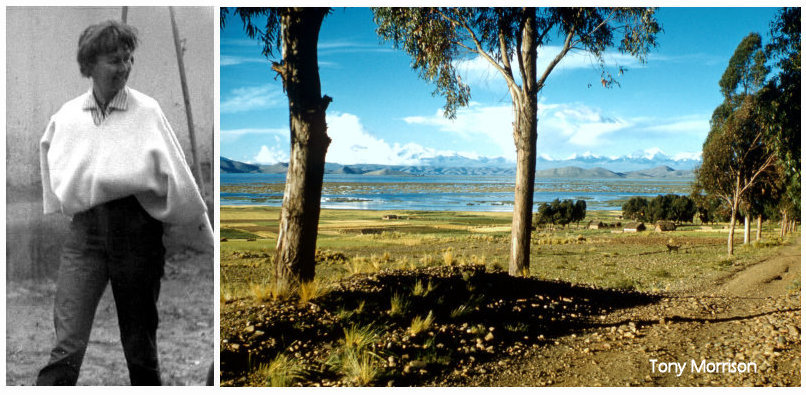
Our
team was based in Pillapi an old hacienda [farm with tied families] near
Lake Titicaca. The view was spectacular to Cordillera Real where some peaks touch
6000m. The Pillapi
hacienda was taken over by the Bolivian State following the National Revolution
of 1952 and the Aymara people were given their own land. When we were there the
farm buildings were being used by a United Nations Andean and Bolivian Government
Programme [Acción Andina] to take education and health care to the
local people. Margaret
Joan Anstee was the UN Head of Mission - here visiting Pillapi. As her career
developed Margaret rose to become an Under-Secretary-General at the UN - the first
woman to hold the post and in Britain, her home she was honoured as a Dame Commander
of the Distinguished Order of St.Micahel and St.George. [I
provided many pictures for her book The House on the Sacred Lake 2009] 10th
April 1961 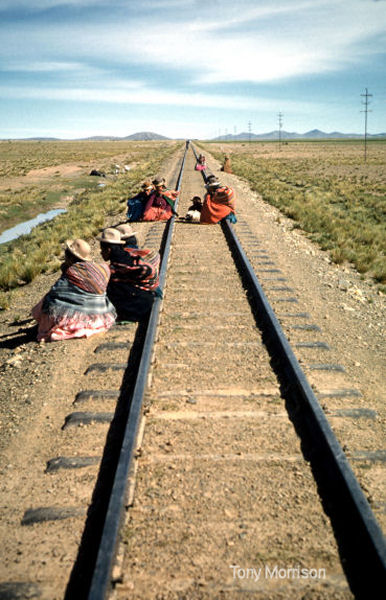 Bolivia,
One of country's best known features is the Altiplano a high plain
set between the Andean moutain ranges. Bolivia,
One of country's best known features is the Altiplano a high plain
set between the Andean moutain ranges.
Here
the main railway crosses the Altiplano at an altitude of about 3650 metres/ 12,000
feet and the local Aymara people would wait for a train, not to climb aboard
but so they could sell food or woven goods to the passengers.
April 1961  Bolivia
The Quechua people of Bolivia are mostly from the mountain valleys to the east
of the Altiplano. Bolivia
The Quechua people of Bolivia are mostly from the mountain valleys to the east
of the Altiplano.
We
were welcomed at several fiestas with music during our journey - here the
panpipe player is wearing a rich red handwoven poncho and a knitted cap decorated
with tiny beads. April
13 1961  Bolivia,
As part of our study of the United Nations work we visited Huanuni a small
settlement for mining families. Bolivia,
As part of our study of the United Nations work we visited Huanuni a small
settlement for mining families.
Way
beneath the ground is said to be the world's largest deposit of cassiterite
- a tin-ore. April
18 1961  Bolivia,
Challapata - This village was a memorable stop. We found a small shop where
a Señora Segundina made coffee and I grabbed a picture of two Quechua country
folk. Bolivia,
Challapata - This village was a memorable stop. We found a small shop where
a Señora Segundina made coffee and I grabbed a picture of two Quechua country
folk.
We were
an hour along the road when Mark Howell realised he had left his miniature tape
recorder at the table. We raced back … and the recorder was there untouched. May
5th 1961  Bolivia
near Cotoca in Santa Cruz department. We were on the fringe of Bolivia's
Amazonia where people, mostly Quechua from the mountains were carving out
a new life. Bolivia
near Cotoca in Santa Cruz department. We were on the fringe of Bolivia's
Amazonia where people, mostly Quechua from the mountains were carving out
a new life.
Heavy
rain over twenty four hours left the earth road virtually impassable and it took
11 hours to cover 25 kms/ 15 miles. All around the Amazonian forest was being
cleared by settlers. May
5th 1961  Bolivia
Settlers in Cotoca Bolivia
Settlers in Cotoca
Today
the settlement has grown to a prosperous town of 46,000 [2018]. May
11th 1961  Bolivia
Cochabamba This skeleton in a basket was in the University Museum in Cochabamba,
then Bolivia's second city. Bolivia
Cochabamba This skeleton in a basket was in the University Museum in Cochabamba,
then Bolivia's second city.
This
way of keeping an ancestor was common among the early people of the Andean region. 7th
June 1961 We had finished our studies and left Bolivia to head north on our way
home
9th
June 1961, Peru
 Peru
near Cusco - Here, Peter Krinks is standing beside one of the massive, hand-shaped
and hand-moved Inca stones of Sacsayhuaman on a hill overlooking Cusco Peru
near Cusco - Here, Peter Krinks is standing beside one of the massive, hand-shaped
and hand-moved Inca stones of Sacsayhuaman on a hill overlooking Cusco
10th
June 1961, Peru  Peru
Machu Picchu, the ruined Inca mountain settlement is now visited by over 1.5
million travellers every year. In 1961 we camped on a hillside and at dawn we
were alone. Peru
Machu Picchu, the ruined Inca mountain settlement is now visited by over 1.5
million travellers every year. In 1961 we camped on a hillside and at dawn we
were alone.
Today
camping is prohibited and access is strictly controlled.
10th
June 1961
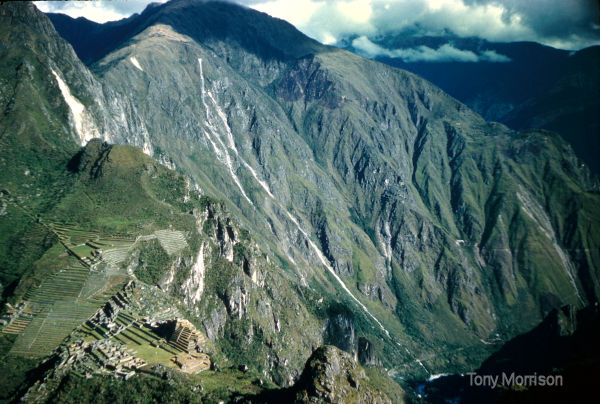 Peru
Machu Picchu
looking down from the top of Huayna Picchu the hunchback peak in the previous
picture. Peru
Machu Picchu
looking down from the top of Huayna Picchu the hunchback peak in the previous
picture.
The
settlement with its temples, stairs and terraces has a planned layout of four
quarters. 17th
June 1961  Peru
Lima Our route northwards took us via Lima where massive poverty-stricken
urban growth was beginning. Peru
Lima Our route northwards took us via Lima where massive poverty-stricken
urban growth was beginning.
I
spent a day in one of the barriadas [slums] where people lived by sorting
rubbish. Today the barriadas are enormous and known as pueblos jovenes
[young towns] . Look at Google Earth 26th
June 1961  Ecuador
- just north of Quito. We crossed the Equator and the team gathered around
the Globe Monument marking Latitude Zero. Ecuador
- just north of Quito. We crossed the Equator and the team gathered around
the Globe Monument marking Latitude Zero.
The
Wrayflex did not have a selfie system built in so I'm not in the picture. 27th
June 1961  Ecuador
In wonderful Andean countryside we met these country folk on their way to a fiesta
aka traditional party. Ecuador
In wonderful Andean countryside we met these country folk on their way to a fiesta
aka traditional party.
The leggings are from sheepskin to keep out the cold and the white trousers are
hand embroidered. 2nd
July 1961  Colombia
Now it was the hot country of Colombia in the Magdalena River valley between Andean
ranges. Cattle ranching
was the local business. Colombia
Now it was the hot country of Colombia in the Magdalena River valley between Andean
ranges. Cattle ranching
was the local business.
By
this point in the journey I was down to the last few rolls of Kodachrome and this
shot was on Ektachrome. The
Ektachrome was affected by the heat and the colour has been difficult to 'restore'.
7th
July 1961
 Barranquilla,
Colombia. We load our two vehicles aboard a C46 cargo aircraft for a quick
hop to Miami, USA. Barranquilla,
Colombia. We load our two vehicles aboard a C46 cargo aircraft for a quick
hop to Miami, USA.
It
is another Ektachrome picture - also difficult to restore. 7th
July 1961  USA,
Miami The picture was taken over Miami as we prepared to land. USA,
Miami The picture was taken over Miami as we prepared to land.
The
flight was so informal that I could shoot pictures from the pilot's cabin. The
story is on the Nonesuch site. Google search Nonesuch Barranquilla.
17
August 1961  Canada
Toronto From Miami we drove north through the USA to Canada where we had a
deadline at an International Fair. The Royal Canadian Mounted Police were on duty. Canada
Toronto From Miami we drove north through the USA to Canada where we had a
deadline at an International Fair. The Royal Canadian Mounted Police were on duty.
From
Canada we drove to New York and Washington. In many places en route we had introductions
from the City of Bristol, England and met all manner of people from businesses,
local government, the arts, academia and more - this was the third project in
our trip.
31st
August 1961
 New
York, Manhattan In
Park Avenue Manhattan and dressed appropriately we are parked outside the British
Consulate. New
York, Manhattan In
Park Avenue Manhattan and dressed appropriately we are parked outside the British
Consulate.
Our
two Austin Motor Company Gipsy 4 x4s had made the distance....just!
2nd
September 1961
 New
York, Manhattan Walking about the city took us to this run-down area in Uptown
Manhattan. New
York, Manhattan Walking about the city took us to this run-down area in Uptown
Manhattan.
After
thousands of kilometres/ miles of quiet open spaces some of the urban scenes were
an extraordinarily depressing contrast.
4th
September 1961  New
York, Manhattan 5th Avenue for Labor Day and a parade. New
York, Manhattan 5th Avenue for Labor Day and a parade.
This
horse drawn carriage is advertising Little Mary Sunshine a musical at the
Off Broadway, Players Theatre.
4th
September 1961  USA
New York Manhattan The foyer of the United Nations building in Turtle
Bay. USA
New York Manhattan The foyer of the United Nations building in Turtle
Bay.
Space was
the theme for the foyer and the design overall is credited to the Brasilian architect
the late Oscar Niemeyer.
4th
September 1961  USA
New York The unforgettable skyline of central Manhattan. USA
New York The unforgettable skyline of central Manhattan.
9th
September 1961
 USA Washington
A space exhibition at the Smithsonian Institution. Five months earlier the
space race had begun with Yuri Gagarin a Russian astronaut in Earth Orbit…..
poyekhali! USA Washington
A space exhibition at the Smithsonian Institution. Five months earlier the
space race had begun with Yuri Gagarin a Russian astronaut in Earth Orbit…..
poyekhali! Mark
Howell is smoking a cigarette at the base of a large rocket.
11
September 1961 We were loaded on to the Gloucester City in Baltimore and then
spent six days picking up cargo in Norfolk Virginia, before setting out across
the Altlantic 17th
September 1961  Atlantic
Crossing At sea on the Gloucester City a Bristol City Line cargo
ship. Atlantic
Crossing At sea on the Gloucester City a Bristol City Line cargo
ship.
We
reached Avonmouth, Bristol, England on 28th September 1961
Technical
Details
Camera
- Wrayflex Model ll
Lenses
-Wray Unilux 50mm F2.8 / Wray Lustrar 35mm F 3.5 / Wray Lustrar 135mm F4
Extension
rings, a lens hood for the 135mm and UV filter
Film
- mostly Kodachrome 35mm [sensitivity 12 ASA ] or Kodak Ektachrome 35mm [Sensitivity
50 ASA ] Both film types were processed by Kodak in Australia, and by a Kodak
agent in La Paz, Bolivia from where Kodachrome was sent to the USA. Ektachrome
was processed in Bolivia
Light
measurement by a separate and hand held Weston Master lll
Flash
was never used. I had flash bulbs and an early type of Electronic flash which
was very unreliable
For long exposures I used a tripod
For
Black and White I used a British made Microflex TLR [Twin lens reflex] and a Leica
lllg lent by F G Warne, Bristol.
| 


 India,
Bandipur Wildlife Sanctuary near Mysore, southern India. We hoped to see a tiger
but had to accept one deer and a fabulous peacock.
India,
Bandipur Wildlife Sanctuary near Mysore, southern India. We hoped to see a tiger
but had to accept one deer and a fabulous peacock. India
, In the Nilgiri Hills in Tamil Nadu state - we were there to see a tea estate.
This view looks to ranges over 2500 metres / 8200 feet high . Although the ages
old tea estates have cut into the ancient forests the Nilgiris are part of the
UNESCO backed Nilgiri Biosphere Reserve.
India
, In the Nilgiri Hills in Tamil Nadu state - we were there to see a tea estate.
This view looks to ranges over 2500 metres / 8200 feet high . Although the ages
old tea estates have cut into the ancient forests the Nilgiris are part of the
UNESCO backed Nilgiri Biosphere Reserve. Here
at the southwestern tip of Ceylon / Sri Lanka we were to meet Arthur C.
Clarke a British science fiction writer who had settled there in 1956 and his
business partner Mike Wilson a film-maker. Arthur C.Clarke perhaps best known
for his co-writing of Stanley Kubrick's 2001 - A Space Odyssey [1968]
was filming the reefs for a sunken treasure story.
Here
at the southwestern tip of Ceylon / Sri Lanka we were to meet Arthur C.
Clarke a British science fiction writer who had settled there in 1956 and his
business partner Mike Wilson a film-maker. Arthur C.Clarke perhaps best known
for his co-writing of Stanley Kubrick's 2001 - A Space Odyssey [1968]
was filming the reefs for a sunken treasure story. In
Colombo, Ceylon / Sri Lanka We boarded the Dutch liner the MV
Willem Ruys - we had booked well in advance as the liner was on a round-the-world
service mainly for European immigrants bound for Australia and New Zealand and
from there Austalians and New Zealanders heading to Europe.
In
Colombo, Ceylon / Sri Lanka We boarded the Dutch liner the MV
Willem Ruys - we had booked well in advance as the liner was on a round-the-world
service mainly for European immigrants bound for Australia and New Zealand and
from there Austalians and New Zealanders heading to Europe.  Singapore,
A sampan in the harbour during a brief stop in Singapore which then was
still part of the British Empire though self governing.
Singapore,
A sampan in the harbour during a brief stop in Singapore which then was
still part of the British Empire though self governing.  On
the deck of the Willem Ruys and about to cross the Equator going
southward.
On
the deck of the Willem Ruys and about to cross the Equator going
southward.  Melbourne
- Australia. Here we were met by Jim Davern who was working for ABC TV. We
had met Jim in Mashad, Iran when he was making his way home from a stay in London
where he had been on a six month attachment with the BBC
Melbourne
- Australia. Here we were met by Jim Davern who was working for ABC TV. We
had met Jim in Mashad, Iran when he was making his way home from a stay in London
where he had been on a six month attachment with the BBC Sydney,
Australia. Picture taken from high on the Harbour Bridge - my diary notes
do not record from which lookout point.
Sydney,
Australia. Picture taken from high on the Harbour Bridge - my diary notes
do not record from which lookout point.  Wellington,
New Zealand An unforgettable departure from Lambton Quay with hundreds of
paper streamers cast from the travellers on the Willem Ruys to families
and friends on the dockside.
Wellington,
New Zealand An unforgettable departure from Lambton Quay with hundreds of
paper streamers cast from the travellers on the Willem Ruys to families
and friends on the dockside. Easter
Island in mid-Pacific is astern.
Easter
Island in mid-Pacific is astern.  February
19th 1961 Arrival in Callao - the port for Lima Peru, where we unloaded our
vehicles and supplies. This picture was not shot on the Wrayflex. It is a 35mm
on a Leica lllg on loan from FG Warne a Bristol photo dealer.
February
19th 1961 Arrival in Callao - the port for Lima Peru, where we unloaded our
vehicles and supplies. This picture was not shot on the Wrayflex. It is a 35mm
on a Leica lllg on loan from FG Warne a Bristol photo dealer. We
were freshly organised and heading south on the tarmac Pan American Highway which
runs through the coastal desert, one of the world's driest places. The
Pacific Ocean is on the right and the foothills of the Andes mountains on the
left.
We
were freshly organised and heading south on the tarmac Pan American Highway which
runs through the coastal desert, one of the world's driest places. The
Pacific Ocean is on the right and the foothills of the Andes mountains on the
left.  Naturally
eroded rock in the Peruvian desert. The Pacific is out of the frame and the Andean
mountain foothills make the backdrop
Naturally
eroded rock in the Peruvian desert. The Pacific is out of the frame and the Andean
mountain foothills make the backdrop At
dawn we had a surprise as we had been camped at a roadside with a perfect view
of the volcano El Misti 5,822 metres / 19,101 feet.
At
dawn we had a surprise as we had been camped at a roadside with a perfect view
of the volcano El Misti 5,822 metres / 19,101 feet.  We
arrived in Bolivia where the administrative capital La Paz is set close to Mt
Illimani 6,438 metres / 21,122 feet.
We
arrived in Bolivia where the administrative capital La Paz is set close to Mt
Illimani 6,438 metres / 21,122 feet.  Bolivia, La Paz - The
500 metres long Paseo El Prado which from the early 1900s was the place
to walk among trees - to admire statues - fountains and fine houses.
Bolivia, La Paz - The
500 metres long Paseo El Prado which from the early 1900s was the place
to walk among trees - to admire statues - fountains and fine houses. Bolivia , La Paz - The old city is out of shot to the left and higher.
Bolivia , La Paz - The old city is out of shot to the left and higher.
 Bolivia,
One of country's best known features is the Altiplano a high plain
set between the Andean moutain ranges.
Bolivia,
One of country's best known features is the Altiplano a high plain
set between the Andean moutain ranges.  Bolivia
The Quechua people of Bolivia are mostly from the mountain valleys to the east
of the Altiplano.
Bolivia
The Quechua people of Bolivia are mostly from the mountain valleys to the east
of the Altiplano.  Bolivia,
As part of our study of the United Nations work we visited Huanuni a small
settlement for mining families.
Bolivia,
As part of our study of the United Nations work we visited Huanuni a small
settlement for mining families.  Bolivia,
Challapata - This village was a memorable stop. We found a small shop where
a Señora Segundina made coffee and I grabbed a picture of two Quechua country
folk.
Bolivia,
Challapata - This village was a memorable stop. We found a small shop where
a Señora Segundina made coffee and I grabbed a picture of two Quechua country
folk. Bolivia
near Cotoca in Santa Cruz department. We were on the fringe of Bolivia's
Amazonia where people, mostly Quechua from the mountains were carving out
a new life.
Bolivia
near Cotoca in Santa Cruz department. We were on the fringe of Bolivia's
Amazonia where people, mostly Quechua from the mountains were carving out
a new life.  Bolivia
Settlers in Cotoca
Bolivia
Settlers in Cotoca Bolivia
Cochabamba This skeleton in a basket was in the University Museum in Cochabamba,
then Bolivia's second city.
Bolivia
Cochabamba This skeleton in a basket was in the University Museum in Cochabamba,
then Bolivia's second city.  Peru
near Cusco - Here, Peter Krinks is standing beside one of the massive, hand-shaped
and hand-moved Inca stones of Sacsayhuaman on a hill overlooking Cusco
Peru
near Cusco - Here, Peter Krinks is standing beside one of the massive, hand-shaped
and hand-moved Inca stones of Sacsayhuaman on a hill overlooking Cusco  Peru
Machu Picchu, the ruined Inca mountain settlement is now visited by over 1.5
million travellers every year. In 1961 we camped on a hillside and at dawn we
were alone.
Peru
Machu Picchu, the ruined Inca mountain settlement is now visited by over 1.5
million travellers every year. In 1961 we camped on a hillside and at dawn we
were alone.  Peru
Machu Picchu
looking down from the top of Huayna Picchu the hunchback peak in the previous
picture.
Peru
Machu Picchu
looking down from the top of Huayna Picchu the hunchback peak in the previous
picture.  Peru
Lima Our route northwards took us via Lima where massive poverty-stricken
urban growth was beginning.
Peru
Lima Our route northwards took us via Lima where massive poverty-stricken
urban growth was beginning. Ecuador
- just north of Quito. We crossed the Equator and the team gathered around
the Globe Monument marking Latitude Zero.
Ecuador
- just north of Quito. We crossed the Equator and the team gathered around
the Globe Monument marking Latitude Zero. Ecuador
In wonderful Andean countryside we met these country folk on their way to a fiesta
aka traditional party.
Ecuador
In wonderful Andean countryside we met these country folk on their way to a fiesta
aka traditional party. Colombia
Now it was the hot country of Colombia in the Magdalena River valley between Andean
ranges. Cattle ranching
was the local business.
Colombia
Now it was the hot country of Colombia in the Magdalena River valley between Andean
ranges. Cattle ranching
was the local business.  Barranquilla,
Colombia. We load our two vehicles aboard a C46 cargo aircraft for a quick
hop to Miami, USA.
Barranquilla,
Colombia. We load our two vehicles aboard a C46 cargo aircraft for a quick
hop to Miami, USA. USA,
Miami The picture was taken over Miami as we prepared to land.
USA,
Miami The picture was taken over Miami as we prepared to land.  Canada
Toronto From Miami we drove north through the USA to Canada where we had a
deadline at an International Fair. The Royal Canadian Mounted Police were on duty.
Canada
Toronto From Miami we drove north through the USA to Canada where we had a
deadline at an International Fair. The Royal Canadian Mounted Police were on duty.
 New
York, Manhattan In
Park Avenue Manhattan and dressed appropriately we are parked outside the British
Consulate.
New
York, Manhattan In
Park Avenue Manhattan and dressed appropriately we are parked outside the British
Consulate. New
York, Manhattan Walking about the city took us to this run-down area in Uptown
Manhattan.
New
York, Manhattan Walking about the city took us to this run-down area in Uptown
Manhattan. New
York, Manhattan 5th Avenue for Labor Day and a parade.
New
York, Manhattan 5th Avenue for Labor Day and a parade.  USA
New York Manhattan The foyer of the United Nations building in Turtle
Bay.
USA
New York Manhattan The foyer of the United Nations building in Turtle
Bay.  USA
New York The unforgettable skyline of central Manhattan.
USA
New York The unforgettable skyline of central Manhattan.  USA Washington
A space exhibition at the Smithsonian Institution. Five months earlier the
space race had begun with Yuri Gagarin a Russian astronaut in Earth Orbit…..
poyekhali!
USA Washington
A space exhibition at the Smithsonian Institution. Five months earlier the
space race had begun with Yuri Gagarin a Russian astronaut in Earth Orbit…..
poyekhali!  Atlantic
Crossing At sea on the Gloucester City a Bristol City Line cargo
ship.
Atlantic
Crossing At sea on the Gloucester City a Bristol City Line cargo
ship.